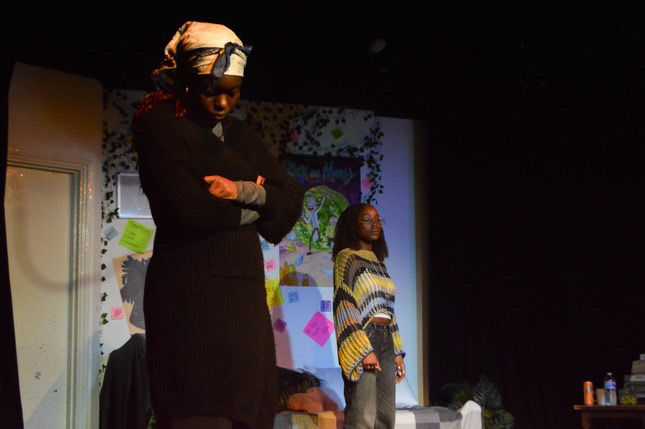Who Deserves Redemption? A Look Into Wahida Seisay's Play 'Symptom of Life'
- sowahzhakiya
- Jul 25
- 4 min read
Wahida Seisay didn’t write Symptom of Life with a neat message in mind. What she had instead was a set of ideas that wouldn’t let her go. Questions about morality, about control, about grace.

“I knew I wanted to write something that kind of encapsulated all my interests,” she says. Philosophy and ethics had stuck with her since sixth form, long after she decided not to study them formally.“I just knew I wanted them to feature in some kind of capacity within the play.”
The result is a piece that doesn’t offer comfort or clarity. Symptom of Life revolves around Lara, a Black woman telling stories from her life, but it quickly becomes clear that the real subject of the play isn’t Lara at all. It’s us, the audience. Most importantly it's about how we choose to respond.
The themes in Symptom of Life unfold gradually, embedded in Lara’s attempts to make herself understood while resisting easy sympathy. Morality, control, and shame intersect as the audience is drawn into the role of quiet judge, forced to decide how much grace to give a woman who refuses to apologise. The audience are met with an exploration of faith as friction rather than the neat resolution we often expect it to be. The tug and pull in the matter of morality encourages the audience to be cognizant of what they believe and how they relate.
When Lara speaks of trusting God, of wanting to change, yet control clings to her like habit, what does that mean to the audience?

“If you are conflicted at the end,” Seisay says, “then you probably did it right.” That tension is intentional. Symptom of Life isn’t looking to create a likable protagonist. It’s asking what happens when someone stands in front of you, flawed and unapologetic, and still demands to be seen.
That lack of apology is the point. Seisay’s fascination with redemption runs through the play, but not in the form of a traditional arc. Lara doesn’t beg to be understood. She’s more interested in holding up a mirror. “If someone is even unremorseful at first, do they still get to redeem themselves?” Seisay asks. “How much grace are we giving them in comparison to other people?” It’s a question about the systems of morality we all participate in, and who we make space for within them.
Lara speaks for most of the play, drawing the audience into what feels like a one-sided FaceTime call. She’s familiar at first, then increasingly uneasy. Her humour, self-awareness, and contradictions unfold through a lens of Blackness, where the pressure to be articulate, composed, and morally legible is constant. Shame: familial, cultural, internal, lurks beneath the surface, shaping what she reveals and what she withholds. She performs and resists at once, always conscious of being watched.

For Black audiences, especially Black women, the play may land differently. “There are scenarios where they’ll be able to see themselves through Lara,” Seisay says. “Especially when it comes to things like Black fatigue, and what’s expected of you.” But the play isn’t framed as “for” any one group. “On a human level, it’s about characteristics of control and self-sabotage. That’s something we all experience.” For non-Black audiences, that balance between relatability and discomfort becomes part of the lesson because sometimes you’re not supposed to fully identify. Sometimes, you’re just meant to listen.
Seisay, who took on much of the sound design herself, uses music and noise to create a physical sense of what Lara is feeling. “I wanted people to feel as overwhelmed by how loud it is, because that’s how Lara feels within herself and within her body.” In one scene, she dials that feeling up so high that the audience can’t escape, they are fully immersed. “You don’t get to sit on a high horse and judge her, because if she’s overwhelmed, you should be too.”

The collaborative process behind the production was as considered as the writing. Directors Maame Oppong-Agyare and Tia-Renee Mullings brought specialisms in spoken word and physical theatre, while the cast spent weeks getting to know their characters off-script, sometimes without touching the text at all. “I would ask them questions about their character that had nothing to do with the play,” Seisay says. “Just to see how deep they could go.” That depth mattered most for Tel Chiuri, who plays Lara, and had to carry the full weight of the play. “At first she was saying what she thought I wanted to hear,” Seisay remembers. “I had to tell her, this character is who you make it.”





![Meet Kendrafilmz: Feeling in Black British Visual Culture [INTERVIEW]](https://static.wixstatic.com/media/1779fb_71c64c1471e04a5a99e21d4b38f196ee~mv2.jpg/v1/fill/w_980,h_1427,al_c,q_85,usm_0.66_1.00_0.01,enc_avif,quality_auto/1779fb_71c64c1471e04a5a99e21d4b38f196ee~mv2.jpg)

![Meet Mayowa: It's 'Just A Party' Redefining Black Nightlife in London [Interview]](https://static.wixstatic.com/media/1779fb_66afc1248e51479bba8fc3fbf4805b68~mv2.jpg/v1/fill/w_980,h_653,al_c,q_85,usm_0.66_1.00_0.01,enc_avif,quality_auto/1779fb_66afc1248e51479bba8fc3fbf4805b68~mv2.jpg)
Comments